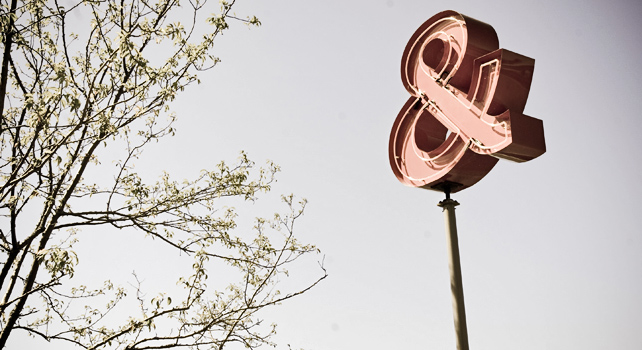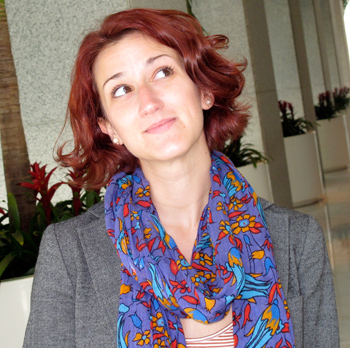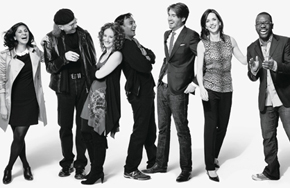What experiences as an archaeologist taught 27-year-old Jessica Goldfin about community-building games, newsroom convergence, and innovation in any occupation.

As an undergraduate student of art and classical civilizations at Florida State University, Jessica Goldfin helped excavate ruins. Today, as special assistant to the president at the Knight Foundation and an advisor at the nonprofit Games for Change, she’s helping not only create the future of media but building better communities, too. Here, she explains how she’s spun internships and an eclectic resume into a career where innovation is the only constant.
FAST COMPANY: You have an undergrad degree in Art History and Classical Civilizations--how did you end up working at the Knight Foundation, a nonprofit that supports journalism and media innovation?
 JESSICA GOLDFIN: When I finished undergrad, I wanted to be a career archaeologist. I like being in the dirt. After school, I got an internship at the Art Institute of Chicago in their publications department, which was the only way I could get in there. At the end of the internship, I was offered a job that was below the poverty line. Instead I went to the University of Miami and started a master’s program in communications studies. I realized that if you can’t communicate what you’re doing, it doesn’t really matter how great the work is--people won’t understand it.
JESSICA GOLDFIN: When I finished undergrad, I wanted to be a career archaeologist. I like being in the dirt. After school, I got an internship at the Art Institute of Chicago in their publications department, which was the only way I could get in there. At the end of the internship, I was offered a job that was below the poverty line. Instead I went to the University of Miami and started a master’s program in communications studies. I realized that if you can’t communicate what you’re doing, it doesn’t really matter how great the work is--people won’t understand it.
At the end of my first year, I thought I should get an internship in communications stuff. This was 2007--before the market crash; Twitter was barely a twinkle in somebody’s eye, and journalism hadn’t completely gone through the revolution it has now. I saw an internship for the journalism program at the Knight Foundation, which is in Miami. I’d taken a class on qualitative research methods, looking at technological convergence in newsrooms, and I went in to the interview and told them all about convergence. Afterwards, my boss at the Knight Foundation, Alberto Ibarguen, told me, “You have no idea what you’re talking about, but you’re plucky.” But no one then knew what they were talking about. Two weeks into this filing internship, I was already so into it.
When my internship ended, I went on a dig in Petra, Jordan. When I came back Knight hired me part-time, and then I got a position as a program assistant, making grants and driving various foundation initiatives. After three and half years, the president of the foundation offered me a job working for him. There was no job description--I still don’t really have one. I said "Okay, let’s do it." It took about five or six months to just understand the new position and get a grip on it. There were growing pains, but at 27 I felt a foot taller than I was at 26. I’m sort of a chief of staff--kind of connecting, aligning opportunities with people and resources better. Seeing the dotted lines between the dots.
About Generation Flux Pioneers of the new (and chaotic) frontier of business Flagship Fluxers, Photo: Brooke Nipar
Flagship Fluxers, Photo: Brooke Nipar
In our February 2012 issue Fast Company Editor Robert Safian identified a diverse set of innovators who embrace instability, tolerate--and even enjoy--recalibrating careers, business models, and assumptions. People like author/Onion digital media maverick Baratunde Thurston, Greylock Data Scientist DJ Patil, Microsoft Senior Researcher danah boyd, and GE's Beth Comstock. This series continues to explore the new values of GenFlux. Find more Fluxers here. And tweet your contributions using #GenFlux.
What gets you so excited about the work that Knight is doing?
The Knight Foundation gives out $110 million a year for projects that support informed and engaged communities. We work across several areas, at the cusp of the future, trying to find people and innovators in whatever sector that can help pull journalism and arts forward. Every day there’s something different. How do you train your mind to see connections and overlap? All of us here are a bunch of workaholics driven by passion--we just kind of want to do stuff that’s progressive, not necessarily in the political sense but in the sense of, how do we move forward?
You were also passionate about archaeology--what did you learn from working on digs?
I fell into archaeology from art history, when I got hooked on Etruscan art. The first dig I went on was a summer in Chianti, Italy, with my mentor Nancy de Grummond at Florida State. I was the only undergrad invited to the dig. I was always the first one up, ready to do what Nancy needed to do. That was unfiltered time with her. I think you can learn any language, skill, or industry, but you can’t learn enthusiasm.
It wasn’t Indiana Jones stuff. You’d work 6 a.m. to 3 p.m. in trenches, going meter by meter. It’s organized deconstruction--like in maker culture, you’re taking something apart to understand how it works. You have to be organized and make sure everything goes in the right bag, note and measure any changes in soil color. Then when you’re out of the trench and back in the lab, you have to go back and make sense of the pieces.
You have to be well-versed in the history and context of the site you’re working on--while knowing that that’s less than 1% of the reality of what that civilization was. You’re constantly triangulating, comparing what you’re finding to what you think you know. The most depressing thing is to dig for weeks and months and then find Snickers wrappers and realize everything you thought isn’t true! It teaches you openness. You have to be completely open to new pieces of information. The best archaeologists are the ones who want to question, not just confirm a set theory or hypothesis.
You’re also on the board of advisors at Games for Change, a nonprofit that promotes games for social impact. How did you get into that?
In 2007, our president created the Knight News Challenge--an open innovation prize. Three of the first six winners were game-related. That was interesting to us. People were starting to explore socially oriented uses of games. In 2008, Knight sent me to the Games for Change conference. Like I think happens with a lot of young people in organizations, I got sent because I was the youngest person at the foundation. We were thinking maybe we could fund a game about the First Amendment. Now I know that was a horrible idea. But within the first hour at the conference, I remember thinking that if we were ignoring games we were doing a disservice to our mission.
Everyone in the world has played games since the beginning of civilization--they are a way of making sense of the world around us and of socializing. Think of how many people play Monopoly or World of Warcraft. Or Angry Birds--the stats on the cumulative time of people playing that adds up to, like, 300 years. Games are compelling and fun, with these nonmonetary rewards that get people to do stuff. The Knight Foundation thought we could do something with using games as a tool to solve community problems or create more community engagement around particular places, and we started working with a game company called Area/Code [since acquired by Zynga] to think about some ideas.
So, what kind of “social impact games” did you come up with?
We knew when we started out that we wanted to explore the ways in which games engage players and how that might translate to real-world places and community engagement--but that was about it! We first worked with our program directors in five communities to identify issues that were topical and relevant. Before we even started thinking about what a game might look like, we first needed to understand the audiences we hoped to reach and the context on the ground to begin defining our design constraints. In the end we worked with Area/Code, the game designers, to create two very different games, designed with our partners, not for them. The trick was balancing the different areas of expertise. We knew we couldn't just give a grant to Area/Code, because they didn’t necessarily know anything about what really made these communities tick. We also knew that we couldn't just work with the community organizations on the ground, because they didn't necessarily have the talent to design a game themselves, or the funding needed to create a good one.
The result was a game called Battlestorm in the Biloxi Gulf Coast region, which was designed to increase youth awareness and empowerment around hurricane preparation, through a real-world battle-game competition. In Macon, Georgia, we created a game called Macon Money, which focused on economic revitalization and creative place-making within the mile and a half College Hill Corridor connecting the local university to the downtown district. Macon Money really captured the community's imagination--people were genuinely excited about this relatively simple game, which used an alternative form of local currency to encourage residents to connect with each other and support local businesses. People got half of a bond and had to find the person who had the other half in order to spend the money. And the coolest part is I got to take Otis Redding's daughter out to breakfast to talk about why we want wanted to put her father’s likeness on the Macon Money bill--since Otis is from Macon--and she agreed!
So, how does someone like you define such a diverse skill set for a potential employer?
It’s a good question, because I’m actually leaving Knight this summer or fall. I told everyone early on--I wanted transparency, and my boss and colleagues have been very supportive in encouraging this next step in my career trajectory.
I wouldn’t trade my eclectic resume for anything, but I think the problem for a lot of intellectually curious people with eclectic backgrounds is thinking about careers by content areas of the places we’ve worked--as opposed to a skill set that kind of cuts across. I wear an ampersand around my neck that I got at a flea market--it’s a constant reminder to be open and remember to keep looking for connections at the intersections of things. You can learn the “language” of any job. The question is are you going to wake up and be excited about what you’re going to do that day.
I’ve had five offers--four of them for positions that I invented and pushed to make happen. Each is in a really different area--the thread is what I can bring to the table. I think my skills are in strategic operations--part strategy, part organizational development. How can you connect ideas, people, and resources? How do you enable people to be their best selves? That’s what interests me. In my job at the Knight Foundation, I’ve learned that leadership can be a lot of things. One is like a hammer--saying, here’s what we’re doing. But maybe power is in understanding others’ strengths, aligning them with the right projects, and enabling them to be their best selves. I don’t need to be the one with the idea. Who cares who makes the idea?--let’s keep it going and see what we can do with it.
[Image: Flickr user Zack Lee]